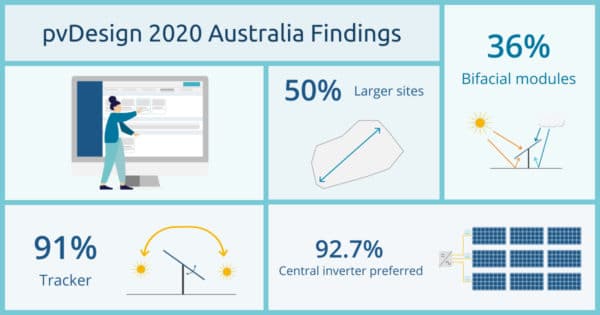Madrid, 1st February 2021: In order to adapt to one of the biggest and most promising solar markets in the world, RatedPower has now included in its software, pvDesign, the Australian Electrical Standard AS 3008.1.1:2017.
Now pvDesign users can choose between the IEC, the NEC or the Australian Standard for electric installations when sizing the cables of their photovoltaic plant.
To size the cables of the PV plant the following criteria must be satisfied:
● Current-carrying capacity criterion: It is defined as the maximum current that can flow through an electric conductor without damaging it. This value varies depending on the conductor, environmental conditions, cross-section, insulating material and the number of grouped conductors, among others.
The operating current is corrected based on the different characteristics of the installation and the site. This corrected value must then be lower than the maximum current-carrying capacity that the cable can withstand, which is based on standard tables.
● Short-circuit temperature rise criterion: When a short-circuit occurs, the amount of current flowing through the conductor might surpass nominal current during short periods of time, which results in heating up the insulator. It is necessary to verify that the proposed cross-section can withstand the maximum short-circuit current. Therefore, the short-circuit current must be lower than the limit supported by the cabling.
● Voltage drop criterion: The criterion states that the voltage drop in each cable should be lower than the maximum values established by the user in pvDesign. Voltage drop limitations impose the use of bigger cable cross-sections, however, not fulfilling this criterion will result in higher losses.

pvDesign will automatically calculate the low voltage (LV) and medium voltage (MV) cables in your PV plant by applying this criteria while considering the following constraints:
● To minimize the costs using the minimum valid cable cross-section(s). pvDesign tends to limit the number of cross-sections to a maximum of two in each sub-system of the PV plant, standardizing the cable cross-sections.
● Copper is proposed as the conducting material for the LV DC string cables and aluminium is proposed as the conducting material for the rest of cables. By adding the Australian Electrical Standards, any users designing PV projects in Australia will comply with the local regulation and therefore their cable sizing will be even more accurate.
This development has been possible because in the past months we have been working in restructuring our code to allow the easier implementation of new electrical standards. In addition, this new algorithm has allowed to include in the Listing of Cables more detailed information that explains how each cable sizing criterion is applied to every cable.
In the following months more standards will join the already available but, at this time, we are ecstatic to help those trying to grow Solar Energy in Australia. All in all, RatedPower will continue to adapt pvDesign not only to the Australian market, but to all of the markets where it has presence, trying to fulfill its customer specific needs while staying a global tool.
If you have any questions with regards to the methodology or would like to see any other standards implemented, please feel free to reach out and tell us more about your ideas. Request a free demo to see this in action. More information: www.ratedpower.com






By submitting this form you agree to pv magazine using your data for the purposes of publishing your comment.
Your personal data will only be disclosed or otherwise transmitted to third parties for the purposes of spam filtering or if this is necessary for technical maintenance of the website. Any other transfer to third parties will not take place unless this is justified on the basis of applicable data protection regulations or if pv magazine is legally obliged to do so.
You may revoke this consent at any time with effect for the future, in which case your personal data will be deleted immediately. Otherwise, your data will be deleted if pv magazine has processed your request or the purpose of data storage is fulfilled.
Further information on data privacy can be found in our Data Protection Policy.